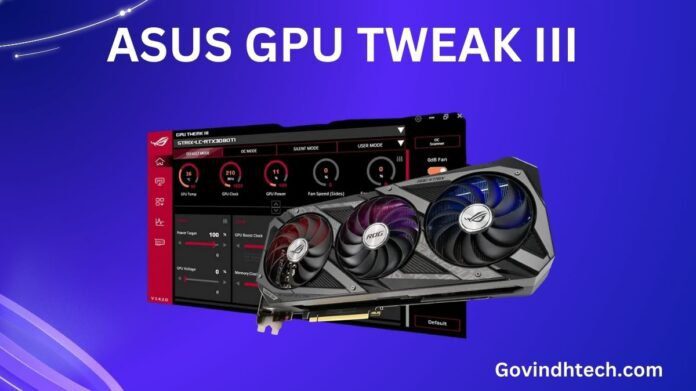ASUS GPU Tweak III: Lower-temperature graphics card undervolting
Players have overclocked graphics cards for years to improve performance. If you’re content with current framerate, but want a card with lower power consumption, heat, and noise? Undervolting helps.
One of GPU Tweak III‘s many features! Browse our GPU Tweak instructions here.
Your gaming experience can improve by undervolting your graphics card, which takes a little time. These two approaches to make your card more efficient with ASUS GPU Tweak III are covered in the guide below.
Disclaimer: Like overclocking, undervolting is safe but may cause instability and crashes during testing. As long as you don’t leave your card at unstable settings, it contains various built-in defences to prevent permanent harm. Continue at danger.
GPU Tweak III Undervolt
Although this first method isn’t undervolting, it will reduce GPU power usage, temperatures, and fan noise with only a slight performance drop.
GPU Tweak III software
A GPU benchmark test should be done before adjusting power use to assess your card’s performance at factory settings. One of your favourite games’ built-in benchmarks or Unigine Superposition, a free benchmark tool. Note your benchmark score and framerate. Follow these steps.
Enter ASUS GPU Tweak III and locate the left-hand Power Target slider. Click Apply in the bottom-right corner after lowering this slider 5 or 10%.
Run your GPU benchmark again and record your score and framerate at the current power target. Additionally, record temps and perceived fan noise for each benchmark.
Follow the above two procedures until the performance dropoff is too steep.
A list of benchmark results at multiple power targets should follow. Since GPU power usage, performance, temps, and acoustics vary every GPU, you can choose the one that best suits you. For instance, my TUF Gaming GeForce RTX 4090 only dropped 4% at 70% power, an astounding improvement thanks to the 40 series’ efficiency. I set my ROG Strix GeForce RTX 3080 Ti LC to 80% for a 5.5% performance decline because performance dropped more steeply below 80%.
Many graphics cards have been manually undervolted over the years, but this is my favoured technique of enhancing GPU efficiency because it’s easy and fast. Continue reading if you want more.
Top performance, low GPU power: undervolt using VF Tuner
The conventional undervolting definition is here. The voltage-frequency curve of every GPU increases with usage. The GPU needs Y voltage for X frequency. Overclocking the GPU allows you to increase performance by slightly increasing its frequency at that voltage.
Undervolting means “run the GPU at the same frequency for lower voltage,” basically the opposite of overvolting. Compared to standard settings, you’ll receive same performance with lower GPU power utilisation, temps, and fan noise, improving user experience.
They recommend one GPU undervolting method over others. Overclocking the card raises the voltage-frequency curve, then manually setting the maximum boost clock to stock values. This make the card hit that frequency at lower voltage than usual.
Find the maximum GPU frequency during hard gaming sessions before starting this operation. Make sure you’re GPU-bound by running your favourite game or benchmark at 98% or above. You’ll see your clock speed in the upper-right corner during the benchmark. It peaks at a certain frequency write this down and that’s your goal for today. ASUS TUF Gaming GeForce RTX 4090 reached 2670MHz, whereas my ROG Strix reached 1920MHz.
After finding your target, undervolt your card:
Increase the GPU Boost Clock by 20MHz in ASUS GPU Tweak III . Apply. Your GPU is overclocked by raising the voltage-frequency curve.
Select VF Tuner. You’ll see your GPU’s increased voltage-frequency curve. Find the graph dot for your selected frequency target and click it. Note the dot’s voltage.
Click and drag to pick all points right of your preset frequency. Click Align Points Down in the pop-up. The curve will level off at your frequency. After clicking Apply, click Save in the lower-right corner to save your settings.
Perform one round of your selected benchmark at high settings (around 99% GPU load). After finishing, put down the GPU Score or average framerate and ASUS GPU Tweak III settings that got it.
After clicking the Default button in ASUS GPU Tweak III ‘s lower-right corner, repeat the following procedures to boost the GPU Boost Clock 20MHz higher. This method flattens the curve at a lower voltage each time. If you raised the curve 20MHz and aligned the points down, it will reach 1920MHz at 880mV. Rerun your stress test, apply your settings, and repeat until you have crashing, artefacts, or other stability concerns.
After the benchmark becomes unstable, return to the previous stable curve and click Save in the lower right corner to save your settings.
The card should boost to the same frequency as at stock settings, possibly more often and with lower power utilisation, temps, and fan noise. Adjust the fan curves more to get the desired effect. To verify stability over a longer session, perform a looping benchmark for a few hours. ROG Furmark, another GPU stability test option after undervolting, appears under GPU Tweak’s left sidebar toolbox.
In rare cases, games may be stable in GPU-bound scenarios but unstable when the GPU is not maxed out because most stress tests use the upper frequency ranges more than lower ones. You may need to lower your curve to obtain stability across all frequencies if some games crash while not GPU-bound. Don’t be afraid to keep adjusting. Undervolting is a vast subject, and we’ve just touched ground today!
Please note that even with the same graphics card, results may differ. Therefore, test on your card rather than applying someone else’s settings. Not all graphics cards can undervolt further than others, but you can be sure you’ve increased efficiency. Celebrate your accomplishments.

